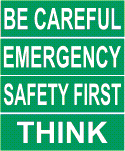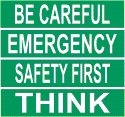OSHA
ANSI
29 CFR 1910.145
ANSI Z535.1 to Z535.5 2011 (R2017)
The OSHA website: http://www.osha.gov/pls/oshaweb/owadisp.show document?p_table=STANDARDS&p_id=9794
Must be purchased to get whole standard. The information below is NOT complete, just for reference. There are several suppliers of the complete standard – this is just one: http://webstore.ansi.org/
29 CFR 1910.145(a)(1) “These specifications apply to the design, application, and use of signs or symbols (as included in paragraphs (c) through (e) of this section) intended to indicate and, insofar as possible, to define specific hazards of a nature such that failure to designate them may lead to accidental injury to workers or the public, or both, or to property damage. These specifications are intended to cover all safety signs except those designed for streets, highways, railroads, and marine regulations. These specifications do not apply to plant bulletin boards or to safety posters.”
ANSI Z 535.2-2011 (R2017) (2.1) “This standard sets forth requirements for the design, application, and use of safety signs in facilities and in the environment.”
SIGN HEADER: • Uses familiar block style headers.
• These headers were used in prior ANSI standards.
• Colors are dictated by hazard signal word
WORDING FORMAT: • Center Justified in the text area
LETTER FORMAT: • All capital letters
SIGN HEADER: • Uses triangle surround exclamation
point for personal injury hazards signs • Common
Size on Hazard Level Signal Words • Colors are
dictated by hazard signal word
WORDING FORMAT: • Left justified in the text area
with correct punctuation
LETTER FORMAT: • Capital and small letters in paragraph
form
OSHA
ANSI
29 CFR1910.145(f)(5)
ANSI Z535.2-2007 (4.11.1)


“Danger tags. Danger tags shall be used in major hazard situations where an immediate hazard presents a threat of death or serious injury to employees. Danger tags shall be used only in these situations.”
“DANGER: Indicates a hazardous situation which, if not avoided, will result in death or serious injury. This signal word is to be limited to the most extreme situations.”
29 CFR 1910.145(f)(7)
ANSI Z535.2-2007 (4.11.2)


“Warning tags. Warning tags may be used to represent a hazard level between "Caution" and "Danger," instead of the required "Caution" tag, provided that they have a signal word of "Warning," an appropriate major message, and otherwise meet the general tag criteria of paragraph (f)(4) of this section.”
“WARNING: Indicates a hazardous situation which, if not avoided, could result in death or serious injury.”
29 CFR 1910.145(f)(6)
ANSI Z535.2-2007 (4.11.3)


“Caution tags. Caution tags shall be used in minor hazard situations where a non-immediate or potential hazard or unsafe practice presents a lesser threat of employee injury. Caution tags shall be used only in these situations.”
“CAUTION: Indicates a hazardous situation which, if not avoided, could result in minor or moderate injury. It may also be used without the safety alert symbol as an alternative to “NOTICE”.”
1910.145(f)(9)
ANSI Z535.2-2007 (4.11.4)


“Other tags. Other tags may be used in addition to those required by this paragraph (f), or in other situations where this paragraph (f) does not require tags, provided that they do not detract from the impact or visibility of the signal word and major message of any required tag.
“NOTICE: “NOTICE” is the preferred signal word to address practices not related to personal injury. The safety alert symbol shall not be used with this signal word. As an alternative to “NOTICE”, the word “CAUTION” without the safety alert symbol may be used to indicate a message not related to personal injury.”
1910.145(f)(9)
ANSI Z535.2-2007 (4.11.5)


“Other tags. Other tags may be used in addition to those required by this paragraph (f), or in other situations where this paragraph (f) does not require tags, provided that they do not detract from the impact or visibility of the signal word and major message of any required tag.
“Signs for safety instructions or safety equipment location: Signs used to indicate general instructions relative to safe work practices or indicate the location of safety equipment.”
